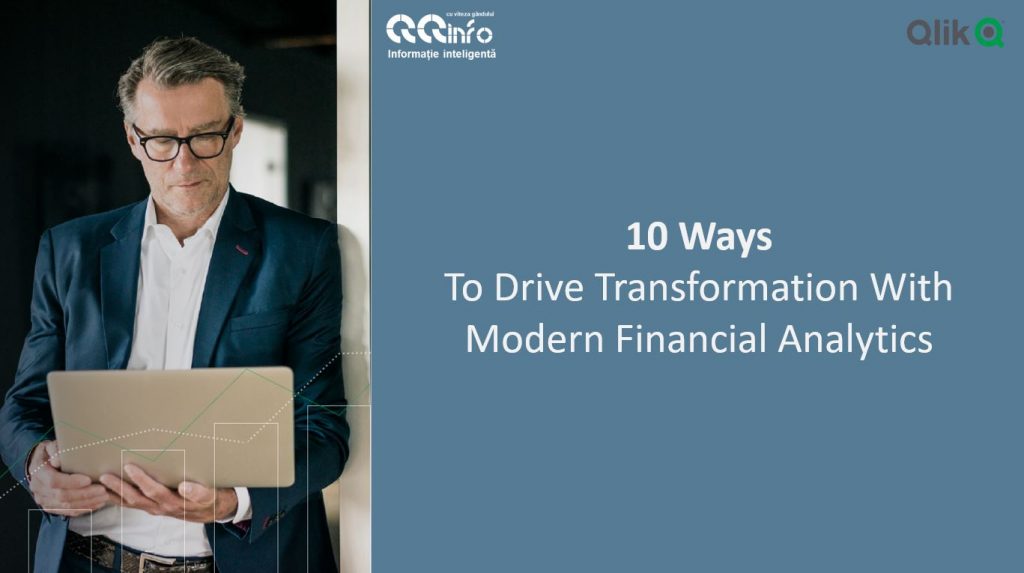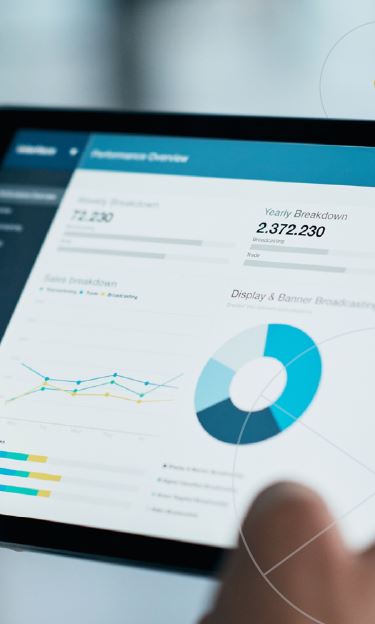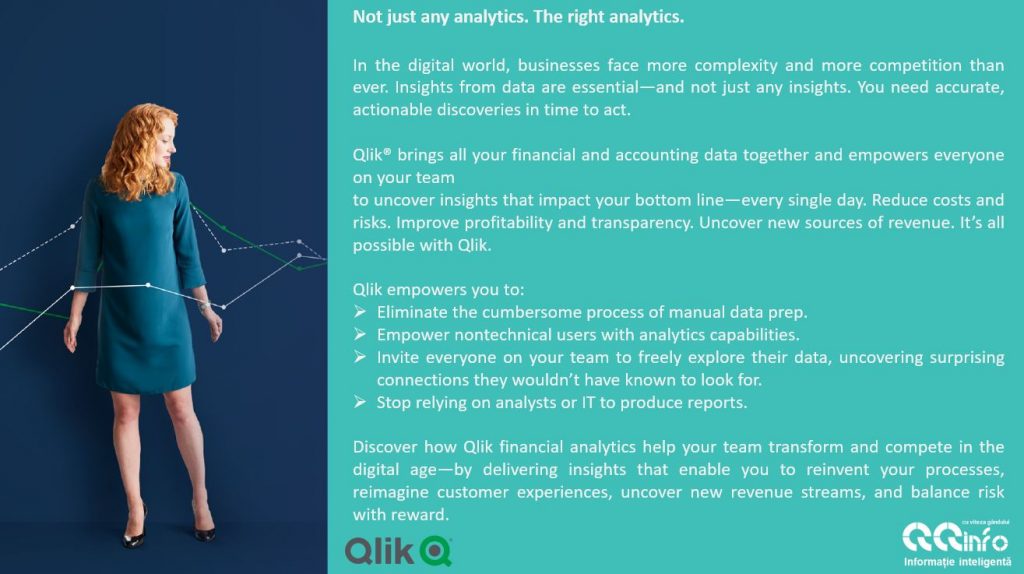
It’s a new era for finance.
And for data.

In the digital era, finance isn’t a business function. It’s a business partner. Executives are looking to CFOs for data-based insights that propel the business forward.
They’re calling on the finance team to be the organization’s “analytics powerhouse,” driving
the analytics agenda for the business. And they’re increasing pressure on finance departments to transition from historical reporting to a forward-looking perspective.
Modern analytics are here to help. Today’s analytics give you unprecedented insights not
only into all your financial KPIs but also into your product performance, customer behavior, competitive threats, market conditions, and more. As a result, you gain the power to revolutionize your business for the digital age.
Industry leaders lean into financial analytics.
78% of best-in-class companies have a “strong” or “highly pervasive” use of analytics within finance.
Where is data having the most impact in finance—and where should you focus your analytical efforts?
We offer you 10 focus directions for transforming the company with modern financial analysis!
1. Manage liquidity.
Liquidity constraints can strangle any business, large or small. But with modern analytics, accounts receivable and payable functions don’t have to be hindered by a slog through manual analysis—or by poor visibility into the financial supply chain.
Modern financial analytics empower you to:
- Align AR and AP systems into a single view
- Take cues from highlighted pressure points to reduce delinquent accounts and take advantage of vendor discounts
- Reduce aged receivables, improving liquidity and optimizing cash resources 10


2. See more clearly into balance sheets.
The financial reporting process is usually labor- and time-intensive, thanks (or no thanks) to multiple systems and data complexity. It doesn’t have to be. With modern analytics, you can seamlessly integrate up-to-the-minute information from all your systems, so you can spend more time analyzing your data and less time cobbling together reports.
Modern financial analytics empower you to:
- See a “flash” balance sheet that enables you to explore and analyze fully integrated financial data
- Much more easily reclassify assets and analyze them from varying perspectives
- Place cash-flow analysis in the hands of your users, who can act more quickly to remedy pressure points
3. Reduce reliance on month-end reporting.
With modern analytics, you don’t have to wait for month-end results. You can see an overview of your current financial standing at any time. That gives you the power not only to improve the quality of your data as it comes in but also to respond more quickly to business issues—and opportunities—as they arise. Even better: It makes the month-end burden a lot less burdensome.
Modern financial analytics empower you to:
- Spot and annotate anomalies in financial reports as they occur
- Reconcile discrepancies before you run final end-of-month balance sheets and P&L statements


4. Gain visibility into compliance and risk.
The data you need to manage compliance and risk is usually produced in different geographies, stored in different systems, and organized into
different categories. Modern analytics bring it all together, giving you an enterprise view of all your risk information—and helping you uncover risks before they become problems.
Modern financial analytics empower you to:
- Establish a complete enterprise view of risk information
- Enable managers to spot and mitigate risks before they occur
- Align compliance with business processes and strategies to
get buy-in from business managers
5. Refine expense management.
Like most financial data, expense data comes in from a range of sources, lives in a variety of systems, and spans an array of geographies. To
analyze it, you need to bring it together into a single platform, where any member of your team can explore it, understand it, and act on it.
Modern financial analytics empower you to:
- Freely investigate costs and expenses across multiple geographies, business lines, and systems
- Understand detailed spending trends and identify opportunities to reduce costs
- Manage expenses in real time, rather than responding after the fact to month-end reports


6. Accelerate insights into markets and pricing.
Every business wants to generate the best possible return on its products. But if your finance users don’t have a way to analyze the massive amount of transactional data in their systems, they can’t spot evolving market behaviors and pricing tradeoffs in their revenue streams. Modern analytics solve that problem.
Modern financial analytics empower you to:
- Put your users at the forefront of revenue data
- Gain insights into changing environments—and act in time to matter
- Get a 360° view of revenue estimates vs. actuals
- Easily identify opportunities to optimize units and prices
7. Improve transparency and communication.
Collecting financial data takes time—and labor. And because every step in the process is contingent on other steps, delays are common. Meanwhile, transparency plummets, because more and more people are waiting to find out what’s happening in the business. Modern analytics put an end to that domino effect, easing collaboration and increasing transparency.
Modern financial analytics empower you to:
- Rapidly analyze an integrated set of near-real time data
- Use collaboration capabilities to share insights with others in
real-time sessions or through annotations - Make better-informed group decisions and business discoveries
- Improve transparency to regulators, executives, and other business lines—with more comprehensive and more accurate reporting of financial data


8. Boost product performance.
Which products make money—and which don’t? It can be tricky to assess each product’s costs individually, given shared production processes and cost bases. But the more granular you can get, the better.
Modern financial analytics empower you to:
- Connect with CRM tools (like Salesforce) to review revenue as it comes in
- Freely explore portfolio performance against goals—from high-level visualizations of total profitability all the way down to transaction detail—to quickly spot outliers and concerns
- Drive growth by reducing margin slippage and risks from lowmargin or underperforming revenue streams
9. Enhance financial planning.
As a finance executive, you’re facing increasing pressure to improve the accuracy of reporting while decreasing turnaround time. The solution? Modern analytics. You can quickly assess budgets and forecasts to spot bottlenecks and find opportunities to reduce costs—and easily identify trends for improved decisions and strategic payoffs—while decreasing the time required for financial closure.
Modern financial analytics empower you to:
- Freely explore business unit performance against financial metrics without manually compiling data
- Get insight into budget allocations and forecast estimates vs. actuals
- Assess what-if scenarios
- Invite managers and staff to add context to activity through annotations
- Share live, fully interactive planning sessions while interacting with your data


10. Get a complete view of the enterprise’s financial health.
Need to quickly uncover redundant expenses or poor pricing? Trying to assess the TCO and real value of contracts while leveraging expense trends and opportunities? There are many reasons for needing a complete financial picture of the enterprise—and with modern analytics, you get one.
Modern financial analytics empower you to:
- See a holistic, multidimensional view of all aggregated expense categories
- Incorporate large volumes of detailed spend data spanning multiple financial ledgers, disparate sources, and different lines of business into the view
- Access information on the go for faster decision-making
